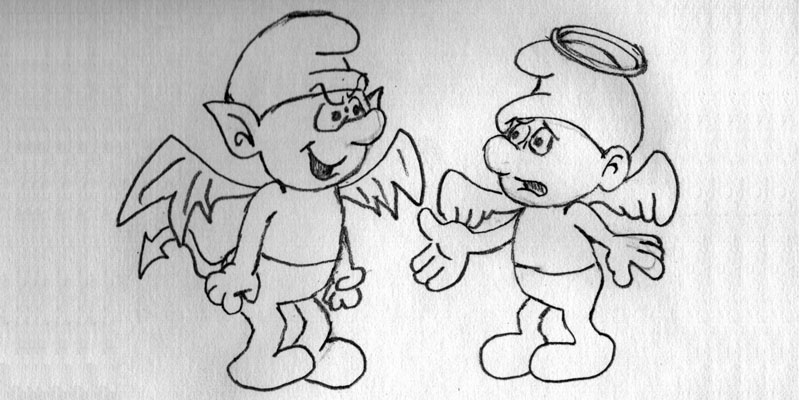In a previous post, MBTI: Not Misleading, Just Misunderstood, I mentioned judging and perceiving dominant functions. I was talking to a friend and believe that I have stumbled upon a good way to differentiate between the two. Consider judging and perceiving in terms of communication.
Judging dominant types are almost always judging what they hear and what they say, but their judgments are works in progress. Such types will give clues, verbal and nonverbal, as to the degree of certainty in what they are saying. They would say something like “In most cases, I think that this is true.” And the progression over time is that the judgments will grow from less certain to very sure. Eventually, they will say, “This is true.” Some things are not judged, some start with no previous judgments, and others have strong judgment immediately (the result of similar decisions in the past). As judgers examine and re-examine, they re-judge until they reach a point where they are strongly certain.
Conversely, perceiving dominant types do not immediately judge unless they have made similar decisions in the past. Without prior judgments, they wait until the very end to decide. Unfortunately, they (especially dominant perceivers with thinking secondary) usually do not give any clue (verbal or nonverbal) as to the level of certainty of their statements, mainly because they have not decided anything as of yet. They would say, “This is false”, and say it with no, little, some, or total certainty; a listener can’t be sure which. Perceivers wish to explore all the possibilities first before deciding on one. What they state may not be certain at all because no judgment may be attached.
The two different styles result in conflict when they communicate with each other. Judging dominants are continuously judging and communicating their level of certainty. Early on or midway through the discussion, they may say “I believe this is so but I may be wrong”. Perceiving dominants instead will state “This is so” without indicating any level of certainty.
Each type believes they are communicating with their own type. Unfortunately, this is may not be the case. A judging dominant would believe that a perceiving dominant is very certain (because there is no verbal qualifier to the statement made) and attempt to figure out why the perceiver believes his statement to be true. A judger would then ask questions and come up with exception cases. The perceiver, who is “just throwing it out there”, is wondering why the judger is questioning him about what he said and attempting to close off possibilities prematurely. The perceiver first responds by trying to answer the judger’s questions, quickly gets annoyed when the questions persist, and start throwing out other statements or possibilities in reply to the exception cases. The judger gets vexed because he views the perceiver as not willing to explain why, making tangential statements that may conflict with each other, and changing judgments randomly. The end result is a communication breakdown and irritation with each other.
The above situation is made worse if any of the two types do not possess high emotional maturity and strong self-esteem. A perceiving dominant would feel under attack by the judging dominant. The perceiver would wonder why the judger is questioning him. A judging dominant would feel that the perceiver is not being serious, being disrespectful and making fun of him. Negative emotions are mixed into the irritation cycle and can build up to eruptions in anger with each other.
Perhaps a better understanding can be arrived at when we consider how each type brainstorms. When brainstorming, judging dominants will make continual judgments that they refine using exception cases. Judgers will examine the feasibility of a possibility before moving on the next one; judgers explore depth first. Perceiving dominants wish to explore all the possibilites before determining any possiblities’ feasibility; perceivers explore breadth first. Seeking refinement, judgers will look for exceptions to what is suggested by a perceiver. The perceiver may feel that is too premature to close off the possibility by questioning. Because statements made by perceivers are viewed as very certain, judgers may feel that it is too premature to make such judgments so soon. Brainstorming becomes an unpleasant experience for both types.
To make my point, I have painted the two types in their extremes. Both types make judgments. For judging dominants, the judgment is spread over the whole process. For perceiving dominants, the judgment is compressed to the end. Unfortunately, a non-judgmental statement said by a perceiving dominant sounds like a definitive statement to a judging dominant. A definitive statement said by a judging dominant sounds like a non-definitive statement to a perceiving dominant. These misunderstandings lead to a communication cycle which will frustrate both types.
The cycle can only be broken if at least one of the types do not assume that they are talking to their own type and make the effort to determine the type they are speaking to. Judging dominant types should not ascribe certainty of judgment to statements made without qualifiers by perceiving dominant types. Absent any expression of degree of certainty, the judger should ask directly whether what was stated is a definitive judgment. Perceiving dominant types should ask if there is any certainty to another’s statement, instead of assuming none, and if possible, provide verbal indicators as to the certainty of their own statements.
When you find yourself getting irritated in a discussion, stop and ask yourself whether your conversation partner is of a different type. Adjust accordingly and with patience, you will communicate and feel better and so will the other person.

